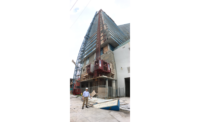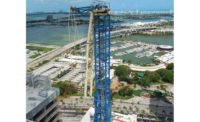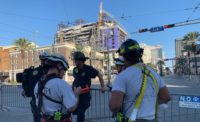In an analysis of three cranes that collapsed in the Miami area on Sept. 10, 2017 as Hurricane Irma passed over Florida, the Occupational Safety and Health Administration found that while the cranes were set to “weathervane,” or spin freely in the wind, all three were a specific model whose jibs may have been vulnerable to turbulent wind vortexes.
The report, published in September, offers an appraisal of why three SK-315 hammerhead cranes came down during the hurricane’s passage over the Miami area. It concludes that while the cranes were not designed to withstand winds over 95 mph at jib height, as seen during Irma, the jibs likely failed due to turbulent wind that imposed violent upward and lateral forces on the jibs. U.S. and European crane regulations do not account for wind turbulence. OSHA’s report recommends that the manufacturer, Terex, consider strengthening the connection between the jib and turntable, which consists of a single pendant in the SK-315. Specifically, the report recommends that “tower tops be evaluated and designed with a higher safety margin, and the design should also be based with loads applied from only the counterjib.”
The question of who may have been at fault in these failures is the subject of ongoing lawsuits. L&R Structural Corp., subcontractor on the Vice project in Miami, where one of the cranes failed, sued crane rental firm Maxim Crane Works in February, alleging the crane was defective. Related Group, developer of Gran Paraiso, where another of the cranes collapsed, is suing both Maxim Crane Works and Terex. Related is also a developer of the Auberge Beach Residences & Spa in Fort Lauderdale, where the third crane failed.
Terex Cranes’ product safety director, Stephanie Wood, says the SK-315 had been designed in the 1990s to meet European and U.S. standards. “That particular model has been in active use in the industry for over 20 years,” she tells ENR. “Hurricane Irma brought uniquely powerful wind forces to bear on South Florida, and there is evidence of micro-burst tornadoes and significant updraft wind bursts on the three cranes in their respective locations. The cranes were not designed or ever expected to withstand those types of forces.”
But the OSHA report raises the thorny issue of the limited options for crane operators when high winds are beyond design specs. “I agree with just about all of the OSHA report,” says Greg Teslia, president of Crane Safety & Inspections, a third-party inspection firm. Teslia, whose firm has inspected cranes in Miami, including one that would later fail, says that when hurricane wind loads exceed design specs, crews can only weathervane and hope for the best.
“There’s really nothing that the contractors could have done to prevent this from happening,” he tells ENR, “besides dismantling the whole crane, which would’ve been impossible in the time they had.” Using tower cranes in hurricane zones comes with risks, he says. “These cranes aren’t made out of armor, and wind is their enemy.”









Post a comment to this article
Report Abusive Comment